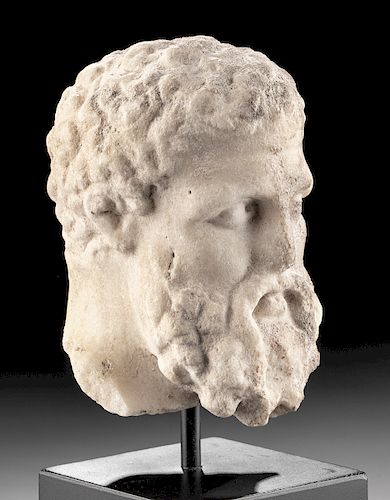Greek Marble Head of Herakles, ex-Christie's, Art Loss
Lot 23
About Seller
Artemis Fine Arts
686 S Taylor Ave, Ste 106
Louisville, CO 80027
United States
Selling antiquities, ancient and ethnographic art online since 1993, Artemis Gallery specializes in Classical Antiquities (Egyptian, Greek, Roman, Near Eastern), Asian, Pre-Columbian, African / Tribal / Oceanographic art. Our extensive inventory includes pottery, stone, metal, wood, glass and textil...Read more
Estimate:
$35,000 - $50,000
Absentee vs Live bid
Two ways to bid:
- Leave a max absentee bid and the platform will bid on your behalf up to your maximum bid during the live auction.
- Bid live during the auction and your bids will be submitted real-time to the auctioneer.
Bid Increments
| Price | Bid Increment |
|---|---|
| $0 | $25 |
| $300 | $50 |
| $1,000 | $100 |
| $2,000 | $250 |
| $5,000 | $500 |
| $10,000 | $1,000 |
| $20,000 | $2,500 |
| $50,000 | $5,000 |
| $100,000 | $10,000 |
| $200,000 | $20,000 |
About Auction
By Artemis Fine Arts
Feb 13, 2020
Set Reminder
2020-02-13 10:00:00
2020-02-13 10:00:00
America/New_York
Bidsquare
Bidsquare : Exceptional Antiquities, Asian, Ethnographic
https://www.bidsquare.com/auctions/artemis-gallery/exceptional-antiquities-asian-ethnographic-4848
An important one-day auction featuring museum-worthy examples of Egyptian, Greek, Roman, Etruscan, Near Eastern, Far East / Asian, Pre-Columbian, African / Tribal, Oceanic, Native American, Spanish Colonial, Russian, Fossils, Ancient Jewelry, Fine Art, so much more! Artemis Fine Arts info@artemisfinearts.com
An important one-day auction featuring museum-worthy examples of Egyptian, Greek, Roman, Etruscan, Near Eastern, Far East / Asian, Pre-Columbian, African / Tribal, Oceanic, Native American, Spanish Colonial, Russian, Fossils, Ancient Jewelry, Fine Art, so much more! Artemis Fine Arts info@artemisfinearts.com
- Lot Description
Ancient Greece, ca. 350 to 300 BCE. A fine portrait of the Greek hero Herakles (Hercules), depicted with thick curly hair and beard, prominent cheekbones, creased forehead and furrowed brow. Though a fragment from a larger statue, what we have here is exquisite and demonstrates a virtuosic command of the medium. Note how the sculptor has captured Herakles' utter exhaustion in this visage. Perhaps our legendary hero has completed his twelve labors as dictated by Eurystheus. Note also that in addition to conveying this weary countenance, the sculptor has also managed to allude to the muscular and skeletal anatomy beneath Herakles' skin. Size: 4.75" H (12.1 cm); 8.875" H (22.5 cm) on included custom stand.
It is similar in type to the famed, contemporaneous depiction of Herakles by the renowned sculptor Lysippos, whose bronze version was erected in the Agora of Sicyon in the Peloponnese, circa 330 BC. Lysippos’ statue was iconic in that it moved away from traditional representations of the hero as a boy or young man engaging in one of his twelve labours and clad in his customary lionskin. Instead, the hero is aged, his muscular body slumped over his club, exhausted after his final labour, clutching the apples of the Hesperides behind his back. The “weary Herakles” type is attested by numerous marble copies from the Roman period (most famous of which is the colossal Farnese Herakles in the Naples Archaeological Museum), but the present head attests to the popularity and importance of the type in the late Classical and early Hellenistic period, perhaps as a precursor to or as a direct result of the Lysippean bronze. Herakles was highly venerated as the greatest of heroes in the ancient world. Considered to be the paragon of masculinity, he was worshipped as the god of strength, athletes, health, agriculture, fertility, trade, oracles and, most importantly, the divine protector of mankind. As the son of Zeus and a mortal, he possessed an unusual “demi-god” status, bridging the gap between mortals and the divine pantheon. His main cult centre was at Thebes, his mythological birthplace, though a large number of shrines were dedicated to him across the Greek and Roman worlds, and festivals, notably the Herakleia, were celebrated in his honour. It is likely that the present piece comes from a votive statuette of the hero from one of his religious sanctuaries. This piece was featured at Christie's London. According to the lot essay, "The present lot may be from a statuette of Herakles, or from a grave stele, which became increasingly elaborate during the 4th Century B.C., often depicting family groups. Cf. 'Marble head of a man from a grave stele', The Metropolitan Museum of Art, New York, inv. no. 1996.522, for a parallel of the style."
One may find a stylistically similar though somewhat larger sculpture at the Metropolitan Museum of Art (27.122.18).
This piece is by a digital Art Loss Register Certificate, reference number S00100789. The piece is also accompanied with an electronic copy of the invoice from Artemis Munzen and Atiquitaten GMBH 1995.
Provenance: private Connecticut, USA collection; ex private Germany collection, 1970s. With Artemis Munzen und Antiquitaten GMBH, Munich, 1995; ex private Canada, collection; ex Christie's, London, 15 April 2015, lot 92
All items legal to buy/sell under U.S. Statute covering cultural patrimony Code 2600, CHAPTER 14, and are guaranteed to be as described or your money back.
A Certificate of Authenticity will accompany all winning bids.
We ship worldwide and handle all shipping in-house for your convenience.
#152764A fragment from a larger statue or elaborate stele with the head of the figure delineated in the round. Normal surface wear commensurate with age. Losses to peripheries of neckline, tip of nose, curls of facial hair, ears, and other high pointed areas, but otherwise the form and details are quite strong. Scattered deposits grace the surface.Condition
- Shipping Info
-
All shipping is handled in-house for your convenience. Your invoice from Artemis Gallery will include shipping calculation instructions. If in doubt, please inquire BEFORE bidding for estimated shipping costs for individual items.
-
- Buyer's Premium



 EUR
EUR CAD
CAD AUD
AUD GBP
GBP MXN
MXN HKD
HKD CNY
CNY MYR
MYR SEK
SEK SGD
SGD CHF
CHF THB
THB
















